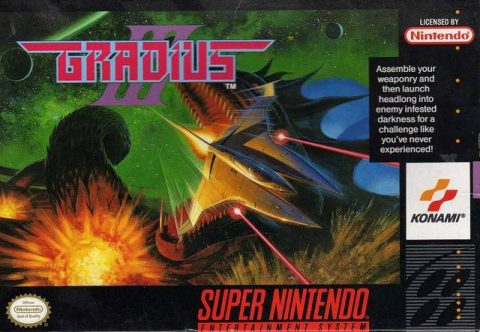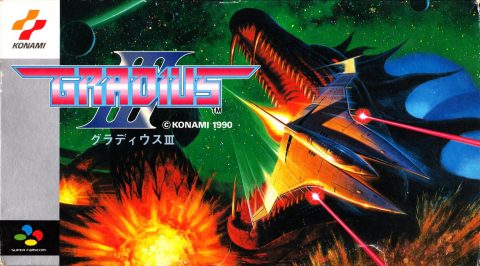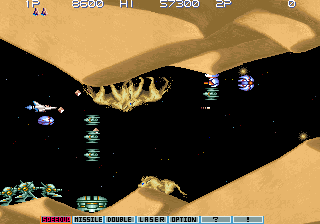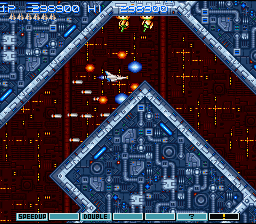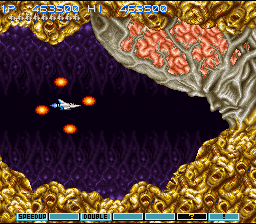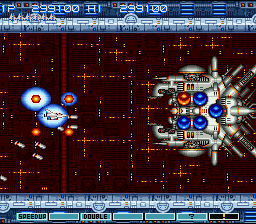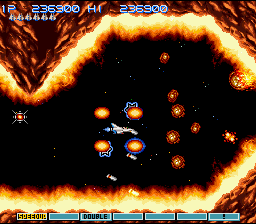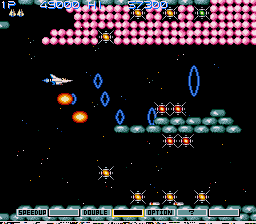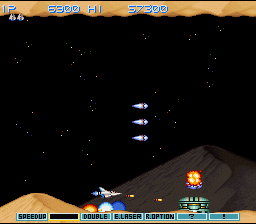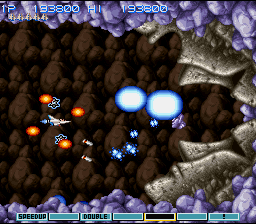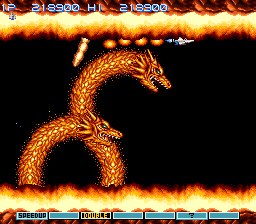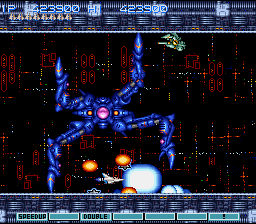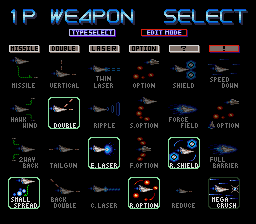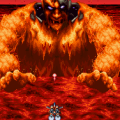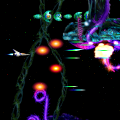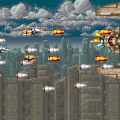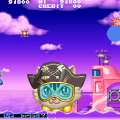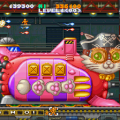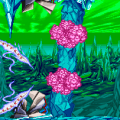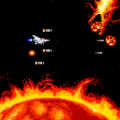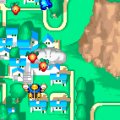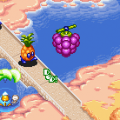The jump between the original Gradius and Gradius II was pretty massive. The same can’t be said for Gradius III (whose subtitle means “From Legend to Myth”). In fact, in some ways it’s actually a bit worse. While the graphics are technically on the same level, the visuals lack the extra flair. Similarly, the music has a vastly different feel to it, and loses a lot of the strong percussion that made Gradius II so memorable, even though the actual compositions are just as good. The music was composed by Junichiro Kaneda, Seiichi Fukami, Miki Higashino, Kozo Nakamura, and Mutsuhiko Izumi.
The first stage takes place in a desert, and even features sand dragons vaguely similar to the flame dragons from Gradius II. The second stage has gigantic deadly bubbles that burst into smaller ones when shot, once again a variation of the crystal stage. The third level is another revisitation of the cave level from the first two games, although this one delves underground and has you carving tunnels through huge expanses of sand. The fourth stage is a weird experiment – a 3D area similar to the bonus levels in Sega’s After Burner. There are no bad guys here. All you need to do is fly through a long corridor, making sure you don’t collide into the walls. Since it scrolls so quickly, this is much easier said than done. It looks pretty cool the first time you see it, but it’s aggravating and feels completely out of place.
The fifth stage is yet another Moai level, while the sixth is an organic fortress, featuring some of those tentacled meteors from the first game. The seventh stage is another flame planet, which isn’t half as interesting as the first stage from Gradius II. The eighth stage introduces another Gradius staple – the plant stage, which ends with a monstrous piece of vegetation that tries to suck up the Vic Viper with its powerful gusts of wind.
The ninth stage comprises of little glass cubes that form corridors and obstacles as you fly through it, which tops off with a boss rush, featuring enemies from the previous games. The final stage is yet another mechanical base, topping off with a high powered escape sequence after defeating the final boss. If you allow yourself to get hit at the final boss, you’ll be transported to a mini stage based on the first level of either Gradius or Salamander.
There are some new and interesting elements in Gradius III, but a lot of it is just variations on themes from the previous games. Plus it’s more frustrating, since the difficulty has been upped even further. As if that wasn’t enough, there’s no way to continue at all, so once you run out of lives, you need to start from scratch. The Japanese version features a “beginner” mode which tones down the difficulty, but only allows you to access the first three stages. This feature is missing from the Asia version of the game, although overall this release is a bit easier.
The only real improvement here is the expanded arsenal. Like its predecessor, there are four different selections, but there’s a new Edit mode, which allows you to pick and choose each of your individual power-ups. However, some weapons are only available in standard weapon select and others only in Edit mode. New weapons include the Free-Way, which can fire in any direction you’re flying in; the Twin Laser, which is less powerful than the standard laser but more focused than the Ripple; the Control missile, which lets you remote control your missiles along with the ship’s movement; and the E. Laser, which can be charged up by holding down the fire button, creating an energy pulse that surrounds the Vic Viper, temporarily acting as a shield against some enemies. There’s also a new Option formation, where they act in a slightly different manner and provide a wider firing range.
The Free Shield lets you stick a shield orb on whatever part of the ship you want, rather than just the front, while the Reduce shield shrinks the Vic Viper, making it easier to dodge projectiles, and can also absorb a single hit. There’s also a new entry on the Power Up bar, denoted by an exclamation point. By default this will remove all power-ups from your ship, but you can also lower the speed if you’ve selected too many Speed Ups, or transfer your extra lives into Options.
Two years after the release of Gradius III in arcades, Konami ported it to the SNES. After so many years of compromised arcade ports for the NES, Gradius III for the SNES looks practically arcade perfect, at least on the surface. Considering it was almost a launch title, it was meant to be a selling point for Nintendo’s then-brand new 16-bit system. Alas, looks can be deceiving, because a lot of stuff either didn’t make it into the SNES port, or was drastically rearranged.
Several enemies were removed, including the sand lions in the first stage, the floating Moai head right before the boss of the Moai stage, a gigantic fire dragon before the boss of the fire stage (different from the worm-like creature that ends up being the final boss), and others are gone. Half of the underground portion of stage 3 is absent, as well as the 3D bonus stage. The eighth stage, the one with the little crystal blocks that assemble the stage as you fly through it, is gone entirely. The sixth stage, the biological level, has been truncated and moved to the end of the game, right before the final boss – the original boss of that stage, a series of brains similar to the Life Force Golem boss, has been ditched. The speed-up zone, which used to be a quick area right after beating the final boss, has been moved up a few stages, is now significantly longer, and includes a new boss.
The final stage is a bit different, mostly in removing some of the legs of the mechanical spider. There are, however, several additional hidden stages in the SNES version. The intro, which originally detailed the history of the Gradius games, has been changed to a cinema of the Vic Viper being launched. The title screen in the arcade version shows the Vic Viper being chased by a dragon, while it’s just empty space in the SNES one.
Despite the downgrades, the SNES version is actually quite a bit better in a number of ways. Most of the visuals are straight out of the arcade version, and in some areas, even look a bit better, like the extra layer of scrolling in the first stage. The music has a different sound to it, using alternate sound samples while keeping most of the same melodies. The SNES version loses the intro theme and one of the navigation songs, but adds in an extra boss theme and some new music for some other areas. It’s also quite a bit easier, having been balanced for home play rather than the brutal arcade challenge – this alone is enough reason to prefer it over the arcade version. Part of this, however, is due to the excessive slowdown, which was common in early SNES shooters. The SNES version also mercifully gives you a few credits.
Some of the weapons in Edit Mode have changed too – the Control Missile and Upper Missile have been replaced with the Hawk Wing and 2Way Back, and the Spread Gun and Free Way are gone. There are two new Option formations – F. Option, which positions all of your Options in a vertical line for an even larger range of fire, and R. Option, which will cause the Options to rotate around the Vic Viper. The Free Shield has been replaced with the R. Shield, which also rotates around the ship. The Reduce shield now lets you take a couple of hits before you expand to the original size. There’s also an additional ability in the ! column – the Mega Crush, which kills everything on screen.
Also, entering the Konami Code when paused will cause you to self destruct, as a sly joke on those who were expecting full power-ups like previous games. If you enter the code with the L and R buttons instead of Left and Right, it will work as intended. In the English manual, the ship has also been renamed the M.A.X.
In the overall context of the series, Gradius III is a bit disappointing. However, from the American perspective, it was fairly well received. Part of which was because the audience hadn’t previously experienced the brutal arcade game, which didn’t hit the States until the PS2 compilation. Part of it was also that Gradius II had never been released there either, so the recycled elements weren’t apparent.
Gradius III has also been rereleased on a few compilations, notably the Gradius III & IV pack for the PlayStation 2, and the Gradius Collection for the PSP. Both of these are based on the arcade version, with the ability to turn off slowdown. The PS2 version also saves checkpoints, allowing you to resume a game you’ve quit, or restart at an earlier point in the level in case you need to power-up. There’s also a bonus “Cube Attack” mode, allowing you to challenge the flying crystal blocks of the eighth stage. You can also unlock an Extra Edit mode if you beat the game, allowing you to pick some of the additional weapons found in the SNES version. The PSP port lacks these features. The SNES version is also on the Wii Virtual Console.
Screenshot Comparisons
Other Arcade Screenshots

